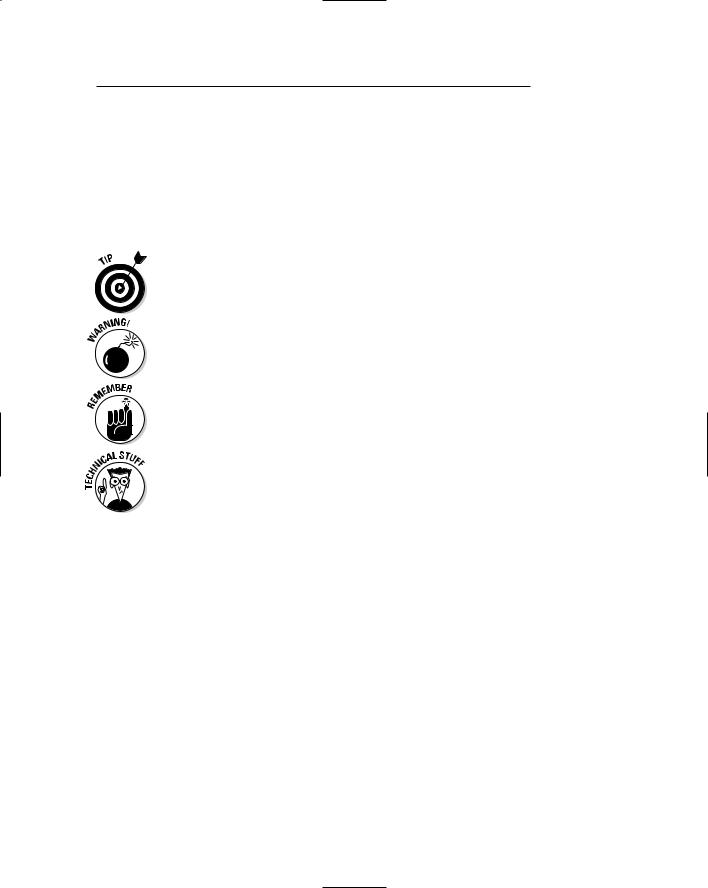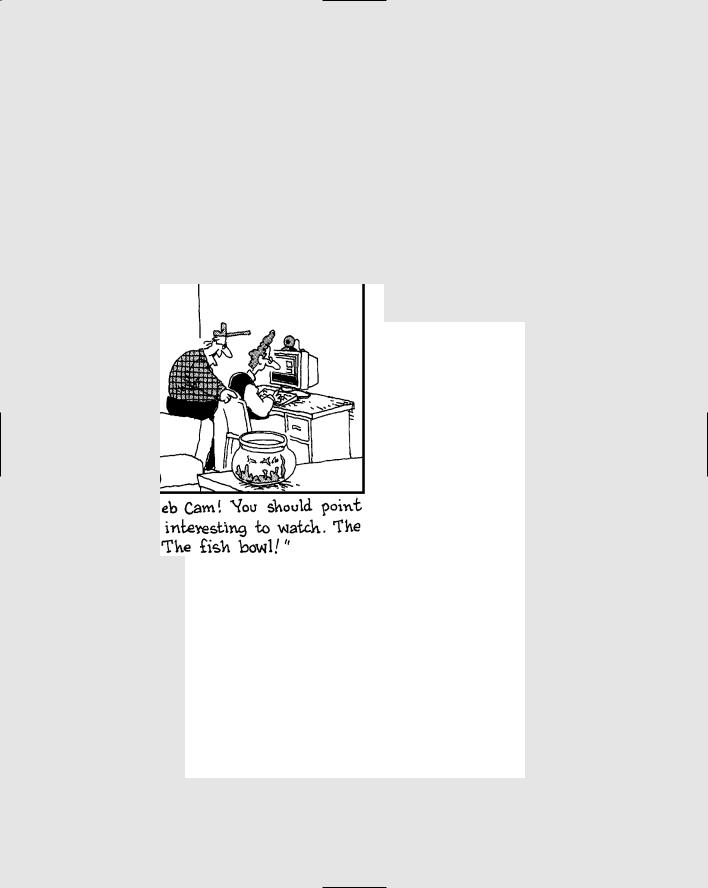
Visual Web Developer™ 2005 Express Edition For Dummies - Alan Simpson
.pdf
xx |
Visual Web Developer 2005 Express Edition For Dummies |

Introduction
Welcome to Visual Web Developer 2005 Express Edition For Dummies.
Visual Web Developer is a tool for developing dynamic, data-driven Web sites. The dynamic part refers to the fact that each page your site sends out can be tailored — on the spot and even on the fly — for whatever person happens to be viewing the page at that moment. The data-driven part stems from the fact that the information needed to create pages dynamically is stored in a database.
Historically, creating a data-driven Web site was an enormous task, requiring countless hours of tedious programming and debugging. Visual Web Developer (VWD) changes all that — allowing you to create dynamic Web sites in a quicker, easier, and more intuitive visual mode where simple drag-and-drop replaces hours of typing code.
That’s not to say that Visual Web Developer is so easy that you can just “think” a Web site into existence. There’s still plenty of knowledge and skill required to develop a Web site. You just don’t need as much knowledge and skill as was required in the pre-VWD olden days.
If you’ve spent much time online trying to figure out how to work Visual Web Developer, you’ve probably been overwhelmed by countless buzzwords and confusing computer code that looks like something written by aliens from another planet. Much of what you’ve seen probably comes from people comparing the VWD way of doing things to the old way of doing things (and that can get obscure in a hurry).
This book takes a different approach: I don’t talk about the old way of doing things at all. There are two reasons for that. The first is, if you don’t know about the old way of doing things, then the comparisons don’t help one bit. And if you do know the old way of doing things, then you can see for yourself how the new way is different without my telling you.
At the risk of sounding smarmy, I might even go so far as to say that the old way of doing this is irrelevant now. By the time you’ve finished with this book, you’ll see what I mean. And you’ll be able to create powerful data-driven Web sites — perhaps without typing any code at all.

2Visual Web Developer 2005 Express Edition For Dummies
About This Book
The main goal of this book is simple: To cover everything you really need to know about Visual Web Developer to create data-driven Web sites. And I do mean “need.” You won’t catch me wandering off into irrelevant product comparisons or advanced topics that few people need.
Another key ingredient of this book is its coverage of things that most other resources assume you already know — in fact, it’s okay if you don’t already know them. Everybody has to start somewhere, and Web-site development is tricky enough without having to fight a feeling of being left out. You won’t get, “Sorry, you didn’t learn our secret language umpteen years ago when we did, so you can’t play.” Here, just about everyone gets to play.
It’s important, especially for newbies, to understand that there’s a big difference between “everything you need to know (just to get in the game),” and everything there is to know. This book makes no attempt to cover everything there is to know about Visual Web Developer (as you’ll notice right away because one person can actually carry the book). The reason is simple: Ten books the size of this one couldn’t cover everything there is to know about Visual Web Developer. So you may need to rely on other resources from time to time. And that’s okay too.
Finally, though I’d like to be able to write this book in such a way that even a fresh-minted PC newbie could follow along, such a goal is unrealistic. Covering everything from your first mouse click to publishing your dynamic data-driven Web site would take too much space — so I have to make some assumptions about who is going to read this book. Which brings us to . . .
Foolish Assumptions
Creating dynamic data-driven Web sites, even with Visual Web Developer, is not a topic for absolute computer beginners. If you just got your first PC a few weeks ago, and so far have mastered only the art of e-mail, you may need to spend quite a bit more time learning Windows basics before you can tackle some of the terms used in this book without getting a headache.
It would be best if you already had some experience creating Web pages on your own. There isn’t really room in this book to discuss things like HTML and CSS in depth. So if those two acronyms are completely foreign to you, then you might want to study up on them before you start using this book.
On the bright side, you don’t really need to know anything, well, technical about ASP.NET or C# or SQL Server to use this book. You’ll use those technologies to create your site, sure enough, but I’ll give you a practical briefing

Introduction 3
in how to boss them around. You don’t have to be a mechanic to drive; likewise, you don’t have to be a programmer or database developer already before you use this book.
Conventions Used in This Book
As you browse through this book you might notice some unfamiliar symbols or odd-looking text in gray boxes. Don’t worry about ’em. The symbol you’ll see in the text just separates individual menu options (commands) that you choose in sequence. For example, rather than saying “Choose New from the File menu” or “Click File in the menu bar, then click New in the drop-down menu,” I just say something like this:
Choose File New from the menu bar.
Creating VWD Web sites doesn’t take much programming. What little code is actually required to perform some task is shown in a monospace font, like this:
if (!Page.IsPostBack) { txtFirstName.Text = Profile.FirstName; txtLastName.Text = Profile.LastName; txtAddress1.Text = Profile.Address1; txtAddress2.Text = Profile.Address2;
txtCity.Text = Profile.City; txtStateProv.Text = Profile.StateProvince; txtZipPostalCode.Text = Profile.ZIPPostalCode; txtPrefTheme.Text = Profile.PreferredTheme;
}
When there are a few little chunks of code to show in text, like this — Profile.FirstName — I show them that way so you can see what is and what isn’t code.
What You’re Not to Read
Reading computer books is not most people’s idea of fun. (though it can be a great cure for insomnia, should the need ever arise). Any text that doesn’t clearly fit into the need-to-know category of using VWD will be marked with Technical Stuff icons (more about those in a minute) or placed in gray sidebars. If you’re in a hurry, or just feel overwhelmed by the need-to-know stuff, you can skip the Technical Stuff and sidebar text. (They’ll still be there when you sneak up on them later.)

4Visual Web Developer 2005 Express Edition For Dummies
How This Book Is Organized
Building a dynamic, data-driven Web site is a process; certain things must be done in a certain order. (A simple example: If you want people to be able to set up accounts on your site and log in, first you have to create some means of storing data about users.) For that reason, this book is divided into parts and chapters that present information in the exactly the same order you need to follow when creating your own Web site. The following subsections tell you what to expect from those parts and chapters.
Part I: Planning a Web Site
Right off the bat, you need to decide whether to have your Web site support capabilities such as site membership, and whether to use the Master Pages feature of Visual Web Developer to give your site a consistent look and feel.
This first part covers all the stuff you need to know if you want to build those features into your site.
Part II: Building Your Web Site
After you have the basic components for site membership and Master Pages in place, you can start focusing on specific content. In this part you’ll discover the Visual Web Developer ways of defining content.
Part III: Personalization and Databases
Chances are, if you use Visual Web Developer to create your Web site, you’ll want to offer more than just basic logins and simple static content. Part III covers topics you need to beef up your site with personalization, themes, and your own custom database tables.
Part IV: The Part of Tens
What For Dummies book would be complete without a Part of Tens? In this part you’ll find a quick reference to the top ten buzzwords every VWD geek needs to know to get into the VWD Geek clubhouse, and resources you can access for information that goes beyond the scope of this book.

Introduction 5
Icons Used in This Book
As you flip through this book, you’ll notice little icons like these sprinkled about its pages. They point out little chunks of text that either deserve a little extra attention or (if they’re obscure) deserve very little attention. For example, a Warning icon points out places where being careless could cause real problems, whereas a Technical Stuff icon points out facts nice to know but not super-important. The icons are
Tips point out handy tricks or techniques that can make things easier for you.
These icons point out techniques where you really need to watch what you’re doing. The world won’t end if you mess up, but fixing the problem won’t be easy.
These icons point out tools and techniques that you’ll use often in VWD, and hence should be high on your priority list of Things to Keep in Mind.
These icons point out text that isn’t desperately relevant to all readers, though useful in an arcane way. You can skip these for now, if you like. They’ll wait.
Where to Go from Here
There’s a definite start-to-finish process to go through if you want to build a data-driven Web site. So if you’re new to Visual Web Developer and are just starting your first site, starting at Chapter 1 is your best bet. Those of you who already have some experience with VWD and have already laid out some components of your sites can jump in anywhere.

6Visual Web Developer 2005 Express Edition For Dummies

Part I
Planning a
Web Site

In this part . . .
Every project has to start somewhere. In Visual Web Developer, that usually means creating a new, empty
Web site and configuring it to support membership. While you’re at it, you’ll need to get the hang of using the program’s major features, and techniques for getting text and pictures into the pages you create. If you want to provide a consistent look and feel for all the pages in your site, you might want to consider creating a Master Page as well. All of those early steps are covered here in Part I.

Chapter 1
Getting Started
In This Chapter
Getting your Web feet wet
Getting around in Visual Web Developer
Getting the help you need, when you need it
Being compatible
Finding someone to host your site
Visual Web Developer (VWD) is a tool for building dynamic, data-driven Web sites. The Express edition, which is the subject of this book, is specifically designed for non-professionals who want to learn to use VWD
and related technologies without having to spring for the tools used by large corporations and professional programmers
That’s not to say you can’t create a “real” Web site with the Visual Web Developer Express. On the contrary, you can build a Web site of any complexity, and copy it to any Web server that supports ASP.NET 2.0 and other related technologies. It’s just that the Express edition doesn’t have some advanced features needed for very large commercial Web sites.
But, as a beginner, you’re probably a long way from developing a large, busy commercial Web site. There’s no need to spring for a more expensive version of the product until after you’ve mastered the Express edition.
Who VWD Is For
Visual Web Developer (VWD) is not a tool for computer beginners. Not by a long shot. VWD allows you to develop fancy Web sites by using existing Web technologies such as XHTML, XML, CSS, ASP.NET, as well as the .NET Framework 2.0, SQL Server, C#, and Visual Basic. In fact, most of the help and documentation for Visual Web Developer presumes that you’re already familiar with those tools and technologies.
